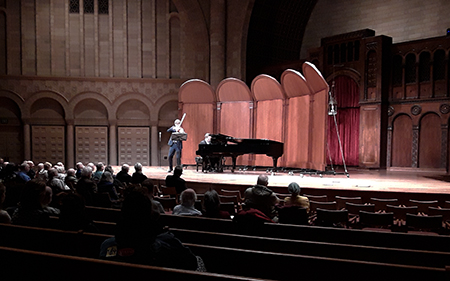by Daniel Hathaway

Ehnes and Armstrong are so perfectly matched in their easy virtuosity that they make the difficult seem facile and the impossible effortless. They spent Tuesday evening spinning out perfectly coordinated passagework and exquisitely-shaped runs without breaking a sweat. Ehnes largely keeps his emotions to himself, but Armstrong’s elastic visage revealed the drama taking place in his mind, and that was fascinating to watch.
The program featured probably the two best-known of Beethoven’s ten sonatas, beginning with the “Spring,” Op. 24 in F, and ending with the “Kreutzer,” Op. 47 in A. In between came the A-Major Sonata, Op. 30, No. 1, whose original finale — outsized for its original purpose — became the last movement of Op. 47.
The “Spring” is melodically lovely, and Ehnes and Armstrong passed its lyrical lines back and forth agreeably, spicing them up with pointed accents and vivid dynamic contrasts. The duo found significance in its tiny Scherzo and Trio, and wrapped the Sonata up with a tranquil reading of its Rondo.
James Ehnes, who always has something interesting to say and speaks easily to the audience, noted that the Op. 30, No. 1 Sonata was written between the second and third symphonies, and can be described as “smiling Beethoven.” And so it was in the performance that followed, featuring exquisite coordination between the two musicians. The slow movement was alluring in its simplicity, and the charming theme-and-variations finale put a right-sized button on the piece.
Speaking again after intermission, Ehnes related the fascinating backstory of the “Kreutzer” before he and Armstrong launched into its unique and dramatic slow introduction and the first of its two Prestos. Hearing the second one right after the Sonata to which it was originally attached was revealing. The tail would definitely have wagged the dog had not Beethoven come to his senses.
The good-sized crowd — larger than it looked in the vastness of Silver Hall — gave the musicians the hearty ovation they deserved. James Ehnes and Andrew Armstrong will complete their Beethoven Sonata cycle at the Maltz on Tuesday, April 21 at 7:30 pm with Sonatas 8, 7, and 10.
Published on ClevelandClassical.com January 21, 2020.
Click herefor a printable copy of this article



